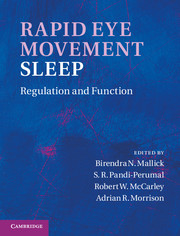Book contents
- Frontmatter
- Contents
- Contributors
- Preface
- Acknowledgments
- Organization
- Section I Historical context
- Section II General biology
- Section III Neuronal regulation
- Section IV Neuroanatomy and neurochemistry
- 19 Aminergic influences in the regulation of basic REM sleep processes
- 20 REM sleep regulation by cholinergic neurons: highlights from 1999 to 2009
- 21 GABAergic modulation of REM sleep
- 22 Glutamatergic regulation of REM sleep
- 23 The role of tuberomammillary nucleus histaminergic neurons, and of their receptors, in the regulation of sleep and waking
- 24 Hypocretinergic system: role in REM-sleep regulation
- 25 Neuropeptides and REM sleep
- 26 Adenosine and glycine in REM-sleep regulation
- 27 Changes in neurotransmitter levels in relation to REM sleep for its regulation
- 28 Pontine areas inhibiting REM sleep
- 29 Neuronal models of REM-sleep control: evolving concepts
- Section V Functional significance
- Section VI Disturbance in the REM sleep-generating mechanism
- Index
- Plate section
- References
26 - Adenosine and glycine in REM-sleep regulation
from Section IV - Neuroanatomy and neurochemistry
Published online by Cambridge University Press: 07 September 2011
- Frontmatter
- Contents
- Contributors
- Preface
- Acknowledgments
- Organization
- Section I Historical context
- Section II General biology
- Section III Neuronal regulation
- Section IV Neuroanatomy and neurochemistry
- 19 Aminergic influences in the regulation of basic REM sleep processes
- 20 REM sleep regulation by cholinergic neurons: highlights from 1999 to 2009
- 21 GABAergic modulation of REM sleep
- 22 Glutamatergic regulation of REM sleep
- 23 The role of tuberomammillary nucleus histaminergic neurons, and of their receptors, in the regulation of sleep and waking
- 24 Hypocretinergic system: role in REM-sleep regulation
- 25 Neuropeptides and REM sleep
- 26 Adenosine and glycine in REM-sleep regulation
- 27 Changes in neurotransmitter levels in relation to REM sleep for its regulation
- 28 Pontine areas inhibiting REM sleep
- 29 Neuronal models of REM-sleep control: evolving concepts
- Section V Functional significance
- Section VI Disturbance in the REM sleep-generating mechanism
- Index
- Plate section
- References
Summary
Summary
The discovery of rapid eye movement (REM) sleep revolutionized the field of sleep research. REM sleep is that state in which most of our dreams occur. During REM sleep, the brain is active, while the body is asleep. These characteristics make REM sleep a unique and a paradoxical state. While we are struggling to understand the function of REM sleep, major advances have been made in understanding the cellular mechanisms responsible for REM-sleep control. In this chapter, we have described two neurochemical substrates involved in REM-sleep regulation. One of them is adenosine and the other is glycine.
Adenosine is implicated to be the homeostatic regulator of sleep. It has been suggested that adenosine acts via A1 receptors to inhibit wake-promoting neurons and promote the transition from wakefulness to sleep. Adenosine acts on multiple wake-promoting systems including the basal forebrain cholinergic and the non-cholinergic systems, namely the orexinergic, and the histaminergic systems. There are reports suggesting that adenosine may act via A2A receptors and activate sleep-promoting neurons of the preoptic region. In addition, studies suggest a direct role of adenosine in the modulation of REM sleep.
During REM sleep, there is a tonic muscle atonia coupled with phasic muscle twitches. This phenomenon is regulated by the dorsolateral pons and ventromedial medulla along with local neurons within the spinal cord. Glycinergic mechanisms are responsible for the control of muscle tone during REM sleep. However, the exact role is under debate.
- Type
- Chapter
- Information
- Rapid Eye Movement SleepRegulation and Function, pp. 256 - 265Publisher: Cambridge University PressPrint publication year: 2011



